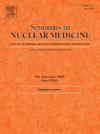The Role of AI in Lymphoma: An Update
IF 5.9
2区 医学
Q1 RADIOLOGY, NUCLEAR MEDICINE & MEDICAL IMAGING
引用次数: 0
Abstract
Malignant lymphomas encompass a range of malignancies with incidence rising globally, particularly with age. In younger populations, Hodgkin and Burkitt lymphomas predominate, while older populations more commonly experience subtypes such as diffuse large B-cell, follicular, marginal zone, and mantle cell lymphomas. Positron emission tomography/computed tomography (PET/CT) using [18F] fluorodeoxyglucose (FDG) is the gold standard for staging, treatment response assessment, and prognostication in lymphoma. However, interpretation of PET/CT is complex, time-consuming, and reliant on expert imaging specialists, exacerbating challenges associated with workforce shortages worldwide. Artificial intelligence (AI) offers transformative potential across multiple aspects of PET/CT imaging in this setting.
AI applications in appointment planning have demonstrated utility in reducing nonattendance rates and improving departmental efficiency. Advanced reconstruction techniques leveraging convolutional neural networks (CNNs) enable reduced injected activities of radiopharmaceutical and patient dose whilst maintaining diagnostic accuracy, particularly benefiting younger patients requiring multiple scans. Automated segmentation tools, predominantly using 3D U-Net architectures, have improved quantification of metrics such as total metabolic tumour volume (TMTV) and total lesion glycolysis (TLG), facilitating prognostication and treatment stratification. Despite these advancements, challenges remain, including variability in segmentation performance, impact on Deauville Score interpretation, and standardization of TMTV/TLG measurements. Emerging large language models (LLMs) also show promise in enhancing PET/CT reporting, converting free-text reports into structured formats, and improving patient communication.
Further research is required to address limitations such as AI-induced errors, physiological uptake differentiation, and the integration of AI models into clinical workflows. With robust validation and harmonization, AI integration could significantly enhance lymphoma care, improving diagnostic precision, workflow efficiency, and patient outcomes.
人工智能在淋巴瘤中的作用:最新进展。
恶性淋巴瘤包括一系列恶性肿瘤,其发病率在全球范围内呈上升趋势,特别是随着年龄的增长。在年轻人中,霍奇金淋巴瘤和伯基特淋巴瘤占主导地位,而老年人更常见的是弥漫性大b细胞淋巴瘤、滤泡性淋巴瘤、边缘区淋巴瘤和套细胞淋巴瘤等亚型。使用[18F]氟脱氧葡萄糖(FDG)的正电子发射断层扫描/计算机断层扫描(PET/CT)是淋巴瘤分期、治疗反应评估和预后的金标准。然而,PET/CT的解释是复杂的,耗时的,并且依赖于专业的成像专家,加剧了全球劳动力短缺的挑战。在这种情况下,人工智能(AI)在PET/CT成像的多个方面提供了变革潜力。人工智能在预约计划中的应用已经证明在减少缺勤率和提高部门效率方面的效用。利用卷积神经网络(cnn)的先进重建技术可以降低放射性药物的注射活性和患者剂量,同时保持诊断的准确性,特别是对需要多次扫描的年轻患者有益。自动分割工具,主要使用3D U-Net架构,改进了量化指标,如总代谢肿瘤体积(TMTV)和总病变糖酵解(TLG),促进了预后和治疗分层。尽管取得了这些进步,但仍然存在挑战,包括分割性能的可变性、对多维尔分数解释的影响以及TMTV/TLG测量的标准化。新兴的大型语言模型(llm)在增强PET/CT报告、将自由文本报告转换为结构化格式以及改善患者沟通方面也表现出了希望。需要进一步的研究来解决人工智能引起的错误、生理摄取分化以及将人工智能模型整合到临床工作流程等局限性。通过强大的验证和协调,人工智能集成可以显着增强淋巴瘤治疗,提高诊断精度,工作流程效率和患者预后。
本文章由计算机程序翻译,如有差异,请以英文原文为准。
求助全文
约1分钟内获得全文
求助全文
来源期刊

Seminars in nuclear medicine
医学-核医学
CiteScore
9.80
自引率
6.10%
发文量
86
审稿时长
14 days
期刊介绍:
Seminars in Nuclear Medicine is the leading review journal in nuclear medicine. Each issue brings you expert reviews and commentary on a single topic as selected by the Editors. The journal contains extensive coverage of the field of nuclear medicine, including PET, SPECT, and other molecular imaging studies, and related imaging studies. Full-color illustrations are used throughout to highlight important findings. Seminars is included in PubMed/Medline, Thomson/ISI, and other major scientific indexes.
 求助内容:
求助内容: 应助结果提醒方式:
应助结果提醒方式:


